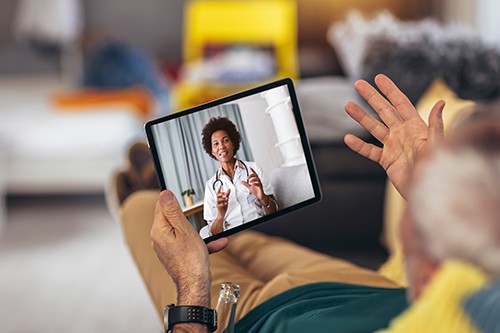What is telehealth?
Telehealth is the use of electronic information and telecommunications technologies to support long-distance clinical healthcare, patient and professional health-related education, and public health and health administration.
Telehealth is not a new concept. In fact, it has been growing in popularity and accessibility since the late 1990s and the exponential growth of the internet. However, until the COVID-19 pandemic, telehealth had been greatly underutilized. Throughout the pandemic, the majority of non-emergent healthcare has been provided via telehealth, allowing for a cultural shift in how people access healthcare.
What are the different types of telehealth?
Telehealth is being used more and more in many different ways in order to allow patients easier access to their healthcare providers. When telehealth is mentioned, it is natural to first think of telephone or video visits. While these are two important forms of telehealth, remote care is more expansive than just these opportunities.
Many providers have patient portals via a smartphone app or website that allow patients to message providers, see test results, and access health records from anywhere they have an internet connection.
What are some uses for telehealth?
There are a variety of ways that telehealth is being used, and the possibilities continue to grow over time. The main uses of telehealth are:
- Chronic disease management
- Mental health visits
- Urgent or sick visits
- Counseling
- Education
- Interdisciplinary consultations
- Diagnostic imaging results
Related: Telehealth: Providing exceptional patient care remotely|
What are the benefits of telehealth?
Telehealth provides a number of key benefits that nurse practitioners can keep in mind when considering remote care. The most obvious benefit is that it allows nurse practitioners the ability to see a patient for whom a face-to-face visit is not possible. There are many reasons a patient might not be able to make an in-person visit, including mobility issues or lack of transportation. Telehealth is especially benefiting rural communities for whom nearby access to health care, especially specialty care providers, is scarce.
As a result, secondary benefits include the ability to see and treat patients more promptly and the expanded availability of health care to patients. Telehealth makes it easy and convenient for patients to connect with providers. This has been shown to decrease readmission rates as patients can be appropriately assessed by a clinician before an issue becomes an emergency.
Throughout the COVID-19 pandemic, telehealth also has the important benefit of decreasing the risk of transmission. Having fewer patients in the office and traveling to and from the office for visits allowed for more social distancing and protection from the virus. Telehealth during the pandemic was especially necessary for patients with chronic diseases to have continuity of care without increased risk of acquiring COVID.
Related: FHEA on YouTube: Benefits of Telehealth
What are the disadvantages of telehealth?
There are some barriers to accessing telehealth that nurse practitioners should keep in mind when offering remote care to patients. First, not all patients will have smartphones, laptops, or reliable internet for virtual calls. Second, many patients may struggle with learning to use new technologies, and nurse practitioners need to consider technology use issues when serving patients, especially older adult populations.
An important clinical consideration for telehealth use is that it may not be possible to complete all steps of a physical examination virtually. This is why telehealth is frequently seen for disease management, education, and mental health visits but not for annual physical exams or examination for a new complaint.
Nurse practitioners should also be mindful of a patient’s privacy when completing telehealth visits, as family members might be nearby and able to overhear a conversation. Finally, there are regulatory issues, both federally and in different states, that dictate when and how telehealth can be provided.
Related: FHEA on YouTube: Disadvantages of Telehealth
What are some pitfalls of telehealth?
Nurse practitioners working via telehealth will experience a number of unique pitfalls to remote communication. Patients may have poor internet connections leading to dropped calls, or video freezing or buffering. It is important for nurse practitioners to have a backup plan when making telehealth visits and to inform patients of this plan. For example, if a patient’s internet connection is not sufficient for a video call, calling the patient on the phone prior to the visit is a good backup to make sure they can still access care.
Unlike seeing patients in an office setting, telehealth has unique challenges of appointment no-shows for nurse practitioners to manage. A practice may require a nurse practitioner to reach out multiple times before declaring a no-show, and it may be frustrating when a patient simply does not answer their phone or come online.
Finally, helping patients learn and navigate the technology used in telehealth can take valuable time from the visit. Nurse practitioners need to be patient and flexible understanding that there may be difficulties with the audio or video or with a patient’s camera or lighting. It can take time to help a patient set up their computer properly to ensure a successful visit. Support staff, if available, are a great way to utilize their skills to help patients navigate the patient portals and sign-on capabilities.
What are some challenges for non-English speaking patients or patients with hearing or visual impairments?
It is not always possible to use an interpreter during a telehealth visit. In accordance with HIPAA guidelines, family members can act as interpreters but is not the ideal situation as there is no guarantee that the information being asked or being answered is accurate. Nurse practitioners should keep in mind that visits needing interpretation will likely take longer than average. Allowing extra time for these visits will help prevent the unneeded stress of getting behind schedule. Utilizing one of the many interpreter platforms that are HIPAA-compliant will provide meaningful access to persons with limited English proficiency or in need of American Sign Language.
What are some tips for nurse practitioners providing telehealth visits?
At the time of the visit, nurse practitioners should start by obtaining consent for the telehealth visit and obtaining the names of anyone present who might be able to overhear the visit. This is an issue of HIPAA compliance that nurse practitioners need to keep in mind anytime a patient’s privacy could be compromised over virtual care platforms.
In terms of completing a physical exam over telehealth, there are ways to assess patients virtually and get an understanding of a patient’s overall physical health. Nurse practitioners can access the patient’s appearance, skin tone, and breathing just through observation on a video visit.
Patients can play an active role in their physical examination, too, in order to provide a better picture of the patient’s health. For example, nurse practitioners can ask patients to tap on their sinuses or point a flashlight in their mouth in order to complete the HEENT portion of an examination.
Learn more about telehealth visits and earn CE hours with our online course on Telehealth: Providing exceptional patient care remotely (free with Passport Membership)!






